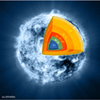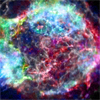CXC Home | Search | Help | Image Use Policy | Latest Images | Privacy | Accessibility | Glossary | Q&A
Tour of Cassiopeia A
Quicktime MPEG
Over three hundred years ago, a very large star ran out of fuel and collapsed. This event created an explosion, known as a supernova, which then produced an expanding field of debris. This debris field is what we now call the Cassiopeia A supernova remnant. Astronomers studying this supernova remnant have found something very interesting. They determined that some of the inner layers of the star before the supernova explosion are now found on the outer edges of the supernova remnant. In other words, it appears that the star has turned itself out, so to speak, at the end of its life. Supernovas and the remnants they create spread elements like carbon, oxygen, and iron into the next generation of stars and planets. Therefore, understanding exactly how these stars explode is very important for knowing how the Universe has gotten to where it is today.
[Runtime: 01:02]
Quicktime MPEG
Over three hundred years ago, a very large star ran out of fuel and collapsed. This event created an explosion, known as a supernova, which then produced an expanding field of debris. This debris field is what we now call the Cassiopeia A supernova remnant. Astronomers studying this supernova remnant have found something very interesting. They determined that some of the inner layers of the star before the supernova explosion are now found on the outer edges of the supernova remnant. In other words, it appears that the star has turned itself out, so to speak, at the end of its life. Supernovas and the remnants they create spread elements like carbon, oxygen, and iron into the next generation of stars and planets. Therefore, understanding exactly how these stars explode is very important for knowing how the Universe has gotten to where it is today.
[Runtime: 01:02]
(Credit: NASA/CXC/A. Hobart)
Chandra X-ray Element Map
Quicktime MPEG
This video of the Chandra X-ray images shows the distribution of iron, sulfur and magnesium in the supernova remnant. The data show that the distributions of sulfur and silicon are similar, as are the distributions of magnesium and neon. Oxygen, which according to theoretical models is the most abundant element in the remnant, is difficult to detect because the X-ray emission characteristic of oxygen ions is strongly absorbed by gas in along the line of sight to Cas A, and because almost all the oxygen ions have had all their electrons stripped away.
[Runtime: 00:16]
Quicktime MPEG
This video of the Chandra X-ray images shows the distribution of iron, sulfur and magnesium in the supernova remnant. The data show that the distributions of sulfur and silicon are similar, as are the distributions of magnesium and neon. Oxygen, which according to theoretical models is the most abundant element in the remnant, is difficult to detect because the X-ray emission characteristic of oxygen ions is strongly absorbed by gas in along the line of sight to Cas A, and because almost all the oxygen ions have had all their electrons stripped away.
[Runtime: 00:16]
(Credit: NASA/CXC/A. Hobart)
Return to Cassiopeia A (March 29, 2012)




